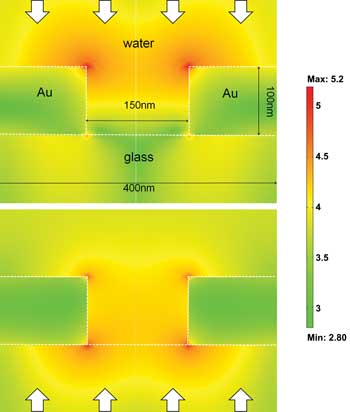
Nanohole-based sensors ideal for medical diagnostics
Novel molecular sensors based on thin metallic films with nanoholes hold promise for applications that require detection of small quantities of molecules, such as gas biomedical diagnostics and gas sensing.
The majority of these applications call for inexpensive disposable sensors, but they must be sensitive enough to detect single molecules.
Ping Bai and colleagues at A*Star Institute of High Performance Computing and the Institute of Materials Research and Engineering have studied the properties of thin-film metallic films with holes in them that show promise for molecular sensing applications.
Metallic thin films with nanometer-size holes are known to transmit light of particular wavelengths efficiently because of surface plasmon polaritons (SPPs), the collective movement of electrons on a metal surface that focus light into tiny spots much smaller than the wavelength of light used.

In surface plasmon polariton (SPP) sensing, nanohole films can be used in two configurations to sense molecules in a water solution. In the reflection mode (top), light is directed at the sample from the water side. In the transmission mode (bottom), it is directed at the sample from the back, leading to different SPP properties. The SPP field intensity is represented by the color plot; the optical fields on the top and bottom are calculated for different resonance frequencies. ©2012 IEEE.
SPPs can detect molecules through the fluorescence of tracer molecules attached to them. The SPPs enhance the fluorescence, which is easily detectable by a microscope, even for small quantities of molecules.
“The whole setup is ultracompact to support a point-of-care sensing system,” Bai said.
The team studied two sensing arrangements: In the first, light was directed at a film with nanoholes at an oblique angle from the same side as the sample. The film in the second arrangement was illuminated from the back so that light traveled through the holes first. The researchers observed that both arrangements had advantages.
In the “reflection” scheme, the SPP effect is stronger because the light is aimed directly at the sample and does not have to cross the metal film. However, a thicker film is needed so that the light does not pass through. The intensity of the light emitted by the molecules is weaker in the “transmission” scheme, but filters and other sensors could be included with the metal film, and the film could be much thinner.
“There is therefore no clear advantage for either sensing mode of such films,” Bai said. “One thing that is clear from the study, however, is the clear benefits of using metal films with nanoholes as a molecular sensing platform.”
This is only a snapshot of the entire project, Bai said.
“Ultimately, our sensing technology will be utilized in hospitals and test centers; for example, in prostate cancer screening, or even used at home just like glucose test kits.”
The research appeared in IEEE Photonics Journal (doi: 10.1109/jphot.2011.217 7652).
Published: September 2012